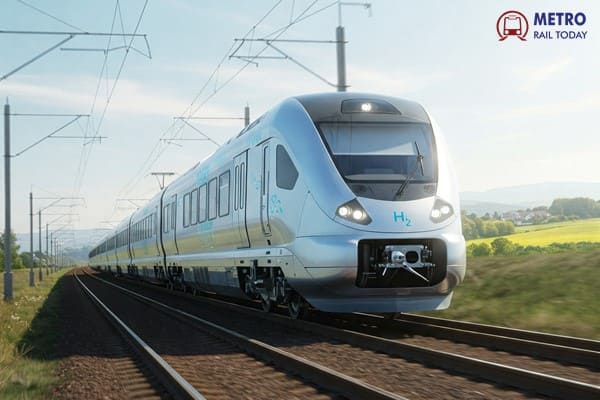 India's Rail & Metro Year-End Review 2025: A Year of Accelerated Execution and Visible Outcomes
India's Rail & Metro Year-End Review 2025: A Year of Accelerated Execution and Visible Outcomes Indian Railways plans to manufacture eight additional sleeper rakes by March 2026
Indian Railways plans to manufacture eight additional sleeper rakes by March 2026 BEML sets timeline for production of high speed trainsets for India's first Bullet Train project
BEML sets timeline for production of high speed trainsets for India's first Bullet Train project Dr. Vinod Shah appointed First Director General of the Chamber of Railway Industries
Dr. Vinod Shah appointed First Director General of the Chamber of Railway Industries Indian Railways to run Namo Bharat Rapid Rail connecting Indore and Ujjain ahead of Simhastha 2028
Indian Railways to run Namo Bharat Rapid Rail connecting Indore and Ujjain ahead of Simhastha 2028 Jaipur Metro Phase 2 to link Airport Terminals, Promise faster Travel and stronger City connectivity
Jaipur Metro Phase 2 to link Airport Terminals, Promise faster Travel and stronger City connectivity HMRTC proposes shared RRTS and Metro operations on Gurugram–Faridabad Metro corridor
HMRTC proposes shared RRTS and Metro operations on Gurugram–Faridabad Metro corridor India launches Chamber of Railway Industries (Rail Chamber) on Good Governance Day
India launches Chamber of Railway Industries (Rail Chamber) on Good Governance Day Bangalore Metro network gears up to grow from its current 96 km to 466 km by 2035
Bangalore Metro network gears up to grow from its current 96 km to 466 km by 2035 South Korea unveils EMU-370, Set to come World’s Second Fastest High-Speed Train
South Korea unveils EMU-370, Set to come World’s Second Fastest High-Speed Train
Demystifying Hydrogen-Powered Trains: A Green Revolution on Rails

In its simplest form, a hydrogen-powered train relies on hydrogen as its primary fuel source, either through a hydrogen internal combustion engine or via a chemical reaction with oxygen in a hydrogen fuel cell. These innovative rail vehicles fall under the category of 'hydrail,' encompassing trains that use hydrogen for their traction motors, auxiliary systems, or both.
The term 'hydrail' was coined by Stan Thompson, a strategic planner at AT&T, who introduced it during a talk titled 'The Mooresville Hydrail Initiative' at the US Department of Transportation's Volpe Transportations Systems Center in Cambridge, MA. This concept gained further recognition when Stan Thompson and Jim Bowman included it in the 17 February 2004 issue of the International Journal of Hydrogen Energy, making it a keyword for professionals in the hydrogen rail sector.
The Hybrid Approach to Hydrail
At present, most hydrail vehicles are hybrids, integrating renewable energy storage solutions like batteries or supercapacitors alongside hydrogen fuel. This hybridization enhances efficiency and minimizes the space required for hydrogen storage.
Versatile Applications
While still in its early stages, hydrail holds immense potential across various railway applications, including industrial and passenger rail, freight rail, mine railways, light and rapid rail transit, and even trams referred to as 'hydrolleys' or hydrogen trolleys. Transport operators worldwide, from China and Germany to Japan, Taiwan, the United Kingdom, and the United States, are actively exploring fuel cell technology and hydrogen generation equipment. Much of this equipment shares similarities with technologies under investigation in the automotive and aerospace industries.
The Inner Workings of Hydrogen-Powered Trains
Hydrogen-powered trains primarily utilize hydrogen fuel cells, which convert hydrogen into electricity through a chemical reaction involving a negative anode and a positive cathode. This process, known as electrolysis, involves hydrogen combined with oxygen to generate electrical energy, with water being the sole by-product. The environmental friendliness of hydrogen production depends on the method used. Steam reforming, utilizing fossil fuels, has a negative environmental impact, whereas electrolysis powered by renewable energy sources or excess grid electricity results in no carbon emissions. Proposals for hydrail often involve producing hydrogen at maintenance depots and storing it in pressurized tanks on the trains.
Advancements in Fuel Cell Technology
Fuel cell technology has advanced significantly, with improvements in fuel cell weight and efficiency. These cells convert chemical energy from hydrogen into electricity, emitting water and heat as by-products. This process is essentially the reverse of electrolysis, which creates hydrogen fuel. However, there are energy losses in both processes, with reports suggesting an efficiency rate of just under 30% for converting electricity to hydrogen and back, comparable to diesel engines but less efficient than electric traction via overhead wires. The electricity generated by fuel cells is then used to power the train's motor.
Compared to natural gas or diesel fuel, hydrogen produced through electrolysis emits zero emissions, offering a cleaner alternative. Even when produced through steam methane reforming, hydrogen emits 45% fewer emissions than diesel-powered trains.
Advantages of Hydrogen Fuel Cells
Hydrogen fuel cell technology offers a multitude of advantages over traditional power sources, making it a compelling choice for a wide range of applications. Here are the key benefits of hydrogen fuel cells:
1. Renewable and Abundant
Hydrogen, the primary fuel for fuel cells, is the most abundant element in the universe. Despite the challenges in extracting hydrogen from water, it stands as an exceptionally abundant and renewable energy source. It holds immense potential to meet our future zero-carbon energy requirements for combined heat and power supplies.
2. Clean and Versatile
Hydrogen fuel cells provide an inherently clean energy source, producing no adverse environmental impact during operation. The only byproducts are heat and water, making it an eco-friendly choice. Unlike other renewable energy sources like biofuels or hydropower, hydrogen doesn't require vast expanses of land for production. In fact, NASA has explored the use of hydrogen for its water byproduct, demonstrating its non-toxic nature. This sets hydrogen fuel cells apart from potentially hazardous or hard-to-obtain sources like coal, natural gas, and nuclear power. Hydrogen production, storage, and utilization play a crucial role in advancing renewable energy by balancing intermittent supply with end-user demands, eliminating the need for significant early investments in grid infrastructure.
3. High Energy Density
Hydrogen fuel cell technology boasts a remarkable energy density. Hydrogen contains the highest energy content per unit weight among common fuels. High-pressure gaseous and liquid hydrogen offer approximately three times the gravimetric energy density (around 120MJ/kg) of diesel and LNG, with a similar volumetric energy density to natural gas.
4. Exceptional Efficiency
Hydrogen fuel cells outperform many other energy sources in terms of efficiency, including various green energy solutions. This heightened efficiency results in the production of more energy per unit of fuel. For instance, conventional combustion-based power plants achieve an electricity generation efficiency of 33-35%, whereas hydrogen fuel cells can reach up to 65% efficiency. This efficiency also extends to vehicles, where hydrogen fuel cells utilize 40-60% of the fuel's energy, along with a 50% reduction in fuel consumption.
5. Almost Zero Emissions
Hydrogen fuel cells produce no greenhouse gas emissions during operation, contributing to reduced pollution and improved air quality.
6. Minimal Carbon Footprint
With virtually no emissions, hydrogen fuel cells leave no carbon footprint while in use, aligning perfectly with sustainability goals.
7. Rapid Charging
Hydrogen fuel cell power units offer lightning-fast charging times, similar to conventional internal combustion engine (ICE) vehicles. This rapid charging capability provides the flexibility and convenience of traditional vehicles.
8. Noise-Free Operation
Hydrogen fuel cells operate silently, eliminating noise pollution commonly associated with other renewable energy sources like wind power. This feature makes hydrogen-powered vehicles quieter than those with conventional internal combustion engines.
9. Aesthetic Compatibility
Unlike some low-carbon energy sources that can be visually obtrusive, such as wind turbines or biofuel power plants, hydrogen fuel cells have minimal space requirements. This results in less visual pollution and a more aesthetically pleasing environment.
10. Extended Usage Times
Hydrogen fuel cells offer impressive usage times, with hydrogen vehicles achieving ranges comparable to fossil fuel-powered counterparts, approximately 300 miles. This range is superior to that of many electric vehicles (EVs). Furthermore, hydrogen fuel cells are less affected by external temperatures and do not deteriorate in cold weather, offering an advantage over EVs. Short charging times further enhance their appeal.
11. Remote Area Applications
In regions where conditions allow, local hydrogen generation and storage can serve as an alternative to diesel-based power and heating in remote areas. This not only reduces fuel transportation needs but also enhances the quality of life for residents by providing non-polluting fuel derived from a readily available natural resource.
12. Versatile Applications
As hydrogen fuel cell technology advances, it becomes increasingly versatile, catering to a wide range of stationary and mobile applications. Hydrogen-powered vehicles represent just one application, with potential uses extending to domestic products and large-scale heating systems. Unlike battery-based systems where power scales linearly with mass, hydrogen fuel cells offer flexibility in design by decoupling energy storage capacity from engine size.
13. Democratization of Energy Supply
Hydrogen fuel cells have the potential to reduce a nation's dependence on fossil fuels, promoting the democratization of energy and power supplies worldwide. This increased energy independence benefits countries currently reliant on fossil fuel imports and helps mitigate the impact of rising fossil fuel prices as reserves dwindle.
Challenges and Disadvantages of Hydrogen Fuel Cells
While hydrogen fuel cells offer promising advantages, they are not without their challenges and disadvantages. Here are the key issues that need to be addressed:
1. Hydrogen Extraction
Despite its abundance, hydrogen doesn't exist in a readily usable form; it must be extracted. The most common methods involve electrolysis of water or separating hydrogen from carbon fossil fuels. Both processes demand a substantial amount of energy, often exceeding the energy gained from the hydrogen itself. Additionally, these extraction methods may rely on fossil fuels, which can undermine hydrogen's green credentials, especially without carbon capture and storage (CCS) technology.
2. Investment Requirements
Hydrogen fuel cell technology requires significant investment to reach a level where it becomes a genuinely viable energy source. Developing this technology necessitates substantial financial and political commitment to improve and mature the technology. The global challenge lies in incrementally building the supply and demand chain in a cost-effective manner.
3. Cost of Raw Materials
Some hydrogen fuel cells require precious metals like platinum and iridium as catalysts, contributing to the initial high cost of fuel cells and electrolyzers. This expense has deterred potential investors and users. To make hydrogen fuel cells a feasible and accessible fuel source, efforts must focus on reducing these material costs.
4. Regulatory Barriers
The lack of clear regulatory frameworks can pose barriers to commercial deployment models for hydrogen technology. Without well-defined regulations that clarify costs and revenue structures, commercial projects may struggle to secure financial investment decisions (FID).
5. Overall Cost
Currently, the cost per unit of power from hydrogen fuel cells is higher than that of other energy sources, such as solar panels. While technology advancements may change this in the future, the existing cost barrier hampers the widespread adoption of hydrogen fuel cells, despite their efficiency once produced. This cost challenge also affects downstream expenses, including the price of hydrogen-powered vehicles, making widespread adoption less likely at present.
6. Hydrogen Storage
Storage and transportation of hydrogen are more complex than those of fossil fuels. This complexity introduces additional costs and logistical challenges for hydrogen fuel cells as an energy source.
7. Infrastructure
The existing infrastructure has long supported fossil fuels, and transitioning to hydrogen fuel cell technology, especially for automotive applications, demands new refueling infrastructure. While long-range applications, such as heavy goods vehicles and delivery trucks, may opt for start-to-end refueling, the need for additional infrastructure remains a consideration.
8. Flammability
Hydrogen is highly flammable, raising legitimate safety concerns. It ignites in air at concentrations ranging from 4% to 75%, making proper handling and safety measures essential in hydrogen-related applications.
Addressing these challenges and disadvantages is crucial for the continued development and adoption of hydrogen fuel cell technology. Efforts in research, innovation, policy development, and investment are essential to overcome these hurdles and unlock the full potential of hydrogen as a clean and sustainable energy source.
Why Hydrogen?
The adoption of hydrogen, especially green hydrogen, as a rail fuel presents several advantages. It supports zero-carbon goals as a clean energy source, providing more potent and efficient energy output compared to fossil fuels. Hydrogen can be stored on trains, making it suitable for lines where electrification is cost-prohibitive due to low service frequency, such as rural diesel-dependent routes.
While rail companies have explored battery power, they currently struggle to store enough electricity to power an entire train, making hydrogen an attractive alternative.
Pioneering Hydrail Examples
Innovators in the rail industry have already made significant strides in hydrogen-powered trains. Alstom introduced the Coradia iLint™, the world's first hydrogen passenger train powered by fuel cell technology, which commenced commercial service in Germany in 2018. This zero-emission train emits only steam and condensed water and operates quietly. It combines hydrogen fuel with battery energy storage for enhanced performance.
The UK unveiled its first hydrogen-powered train, the HydroFLEX, in 2019. Based on a Class 319 train, it features hydrogen fuel tanks, a fuel cell, and lithium-ion battery packs. This bi-mode electric hydrogen train generates electricity by converting hydrogen and oxygen, with additional power provided by the battery packs.
In summary, hydrogen-powered trains represent a promising and sustainable future for rail transportation. With ongoing technological advancements and growing interest from railway operators worldwide, hydrail is poised to play a significant role in reducing emissions and revolutionizing the railways. However, addressing infrastructure challenges will be crucial to realizing the full potential of this green revolution on rails.







